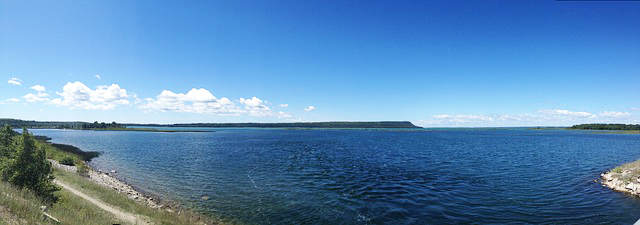KINCARDINE—A proposal by Ontario Power Generation (OPG) to create a deep geological repository (DGR) to store low and intermediate level nuclear waste deep within the bedrock below the Bruce nuclear power site has been given the all clear by a federal Joint Review Panel Report (JRPR), leaving only 120 days for interveners in the JRPR hearing process to file further comment before a decision by the Environment Minister Leona Aglukkaq could approve the project.
“The Panel concludes that the project is not likely to cause significant adverse environmental effects given the measures contemplated to curb them,” reads the report submitted by the JRPR to the environment minister on May 6.
“OPG developed the DGR with one goal in mind: to create permanent, safe storage for Ontario’s low- and intermediate-level nuclear waste,” said senior vice-president Laurie Swami in a short release from a jubilant OPG. “We are pleased with the panel’s conclusion that the project will safely protect the environment.”
For the 152 communities opposed to the project, many of which have passed resolutions against the project and which cover both sides of the border and include both Chicago and Toronto among their number, the lobbying to kill the proposal will invariably intensify to a fever pitch and will most likely include the both the US federal houses of congress.
The 432 page report, with its favourable conclusions, assists the OPG DGR project in leaping over its most significant hurdle in locating the nuclear waste site within about a thousand metres of the water of the Great Lakes.
In the proposed DGR site, OPG plans to bury as much as 200,000 cubic metres of low- and intermediate-level radioactive waste from its nuclear power plants, nestling material such as gloves and coveralls packed in secure bins within a thick layer of limestone located 680 metres below ground, barely a kilometre from the shores of Lake Huron. OPG claims that the limestone rock is so solid and stable it will successfully contain any possible leakage of harmful radioactivity.
Environmentalists most emphatically disagree.
“The last place to bury and abandon radioactive nuclear waste is beside the largest body of fresh water in the world,” said Beverly Fernandez of Stop the Great Lakes Nuclear Dump, following the report’s release.
First Nations leadership has vowed to stop any such plan from coming to fruition.
“The uncertainties and risks are too great for the Anishinabek Nation and Ontario citizens to consider,” said Grand Council Chief Patrick Madahbee following the release of the report. “The Anishinabek Nation passed a resolution, and we have informed governments before, that ‘the Anishinabek Nation will stand united and oppose any deep geological nuclear waste repositories within the Anishinabek Nation territory’.”
“If something were to happen with the disposal or the leakage of nuclear waste I wouldn’t want to be drinking the water downstream,” said Saugeen Chief Vernon Roote. “That means the balance of Lake Huron, Lake Erie, Lake Ontario and also anyone drinking from those lakes, even into the US.”
Environmentalists point out that the Great Lakes provide drinking water to 40 million people and contain a major portion of the world’s supply of fresh water.
If the critics of the plan are unsuccessful in derailing the plan at the political level, shovels could be digging the site by 2018 and the $1 billon project opening by 2025 at the earliest.
Despite opposition to the plan, the JRPR dismisses the concerns that were raised at last year’s hearings, asserting that there would be “no significant adverse effects on Lake Huron or the other Great Lakes.”
Any release of radiation, reads the report, “would be extremely low relative to current radiation levels in Lake Huron and negligible relative to dose limits for the protection of the public.”
The panel report accepts the OPG assertion that the rock where they plan to place the DGR is extremely stable and the concurrent claim that fluids contained in the rock would travel at a such a slow rate, even in geological terms, that any radioactivity that could escape would decay before reaching the lake.
The report also accepts that the although the OPG decided to construct the waste storage facility at the Bruce site without any meaningful investigation of alternative sites the Bruce location was a good choice.
“The relative environmental effects of constructing a DGR on an undeveloped site would be higher than on the already disturbed Bruce nuclear site,” the report concludes, adding that “there would be socio-economic challenges at an undeveloped site.”
The panel also asserted that the Bruce nuclear site is already highly secure, suggesting that “the risk of malevolent acts is already managed and low.”




